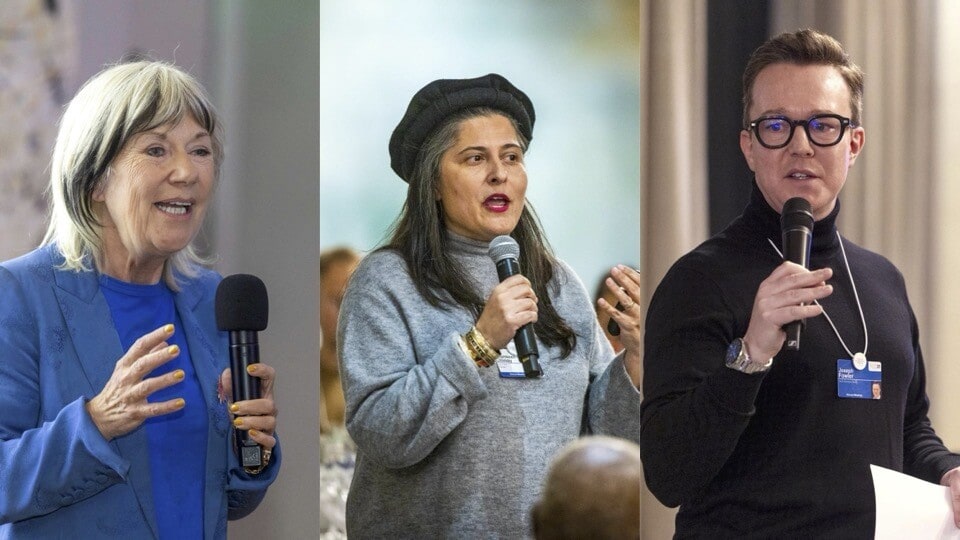Collisions: 'This story I carry is until the end'

An image from the film Collisions Image: Piers Mussared
I first heard of Nyarri’s story four years ago on a hunting trip with the Martu women painters of Australia’s Western Desert. Hearing that I had been to Maralinga, where Britain tested atomic bombs in the 1950’s, Nyarri’s wife Nola turned to me directly and said,
”You have to talk to Nyarri.”
A year later I returned to the Parnngurr community and on a stiflingly hot day filming the women painting in the tin art shed I met Nyarri. He came into the shed, and sang for rain. As clouds gathered in the sky outside I asked him about Maralinga. I heard a short, powerful parable that Nyarri had waited almost his entire life to share. What he told me was a story only about four or five sentences long but hearing it changed everything.
Nyarri told me he had been in the Maralinga region as a young man and had seen first hand an atomic test. This was in the 1950’s, before the Martu had any contact with the Western world at all, so I asked him what did you think that was? His answer is the whole reason this work exists. An answer so simple as to seems completely obvious, but only once you have heard it.
His answer and its implications is why this story had to be shared.
So this new work Collisions was born, as a thought or an imagining.
I hadn’t yet experienced Virtual Reality and I was waiting to decide the form that would best suit this work. I experienced my first VR film almost a year ago today, and when I saw it I knew what was needed to make Nyarri’s story come alive.
Quite simply, Virtual Reality places the viewer inside the film. It creates presence where before there was only observing. This fundamental shift in perspective changes everything. It makes everything personal because we feel present and so it does the thing I had been striving for in so many ways, in so many works, it makes us all feel connected to what is happening. VR was the technology I had been waiting for.
I love new technology. I love the moment when the viewer experiences a new sensation for the first time. I know the uniqueness of that moment gets seared into memory. I also believe in the power of story to reshape us collectively and Nyarri’s story is a powerful one. So it seemed to me that the two belonged together.
VR will soon hit in a big way, very possibly to become ubiquitous. In the window of time that exists before then, I wanted to make a work that has protocols of meeting with a remote community at its core.
Nyarri’s world is only available to me to visit, and in this work through the technology, that invitation is extended to the viewer. The agency in Collisions belongs to Nyarri. When I put the camera down in front of him he said, “It has sixteen eyes.” I replied that it has sixteen eyes and four ears. From that moment Nyarri become the one who decided what was seen and what was not to be seen, what was told and what was not told. Nyarri knew who it was he was speaking to. He was speaking to us.
So this work is something of a gift sent out from a private world. It contains an old story, held close till now. But it also needed to be a film that bridges cultures because the story is about a collisions of worlds - our world and Nyarri's. So it has two narrators and it has a meeting between two old men at its core, men whose lives are inextricably linked but who never met. It is a technological message in a bottle to a world that teeters on the edge of climate catastrophe, but it is a message shared with a fundamental hope in our capacity to contemplate more carefully, with long-term thinking, the consequences of our actions.
At the World Economic Form in Davos and the Sundance Film Festival in Park City, with Nyarri travelling for the first time away from his home to join us, I am so happy to able to share this experience with Nyarri, his family and you. As he says in his native Martu language:
" Ngaa-nga jarkulparna kartinpa yulubidyi, Jarmukurnu Yaparlyikurnu mirda kujtu ngaryukuju parlparryikujanumpa, yuwa palya."
"This story I carry is until the end, from our Grandfathers and Grandmothers not just my story alone, for everyone, thank you."
Don't miss any update on this topic
Create a free account and access your personalized content collection with our latest publications and analyses.
License and Republishing
World Economic Forum articles may be republished in accordance with the Creative Commons Attribution-NonCommercial-NoDerivatives 4.0 International Public License, and in accordance with our Terms of Use.
The views expressed in this article are those of the author alone and not the World Economic Forum.
Stay up to date:
Arts and Culture
Forum Stories newsletter
Bringing you weekly curated insights and analysis on the global issues that matter.
More on Arts and CultureSee all
Elena Raevskikh and Giovanna Di Mauro
October 22, 2025






